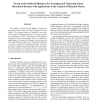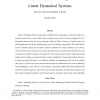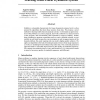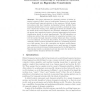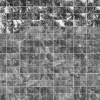CVPR
2012
IEEE
12 years 9 months ago
2012
IEEE
We introduce a framework for defining a distance on the (non-Euclidean) space of Linear Dynamical Systems (LDSs). The proposed distance is induced by the action of the group of o...
103
click to vote
JMLR
2012
12 years 9 months ago
2012
Temporal Clustering (TC) refers to the factorization of multiple time series into a set of non-overlapping segments that belong to k temporal clusters. Existing methods based on e...
ICASSP
2010
IEEE
14 years 5 months ago
2010
IEEE
Least-squares estimation has always been the main approach when applying prediction error methods (PEM) in the identification of linear dynamical systems. Regardless of the estim...
CORR
2010
Springer
14 years 7 months ago
2010
Springer
Takens' Embedding Theorem remarkably established that concatenating M previous outputs of a dynamical system into a vector (called a delay coordinate map) can be a one-to-one...
NIPS
2007
14 years 8 months ago
2007
Stability is a desirable characteristic for linear dynamical systems, but it is often ignored by algorithms that learn these systems from data. We propose a novel method for learn...
CDC
2008
IEEE
14 years 8 months ago
2008
IEEE
The paper deals with the problem of reconstructing the tree-like topological structure of a network of linear dynamical systems. A distance function is defined in order to evaluat...
ICAPR
2005
Springer
15 years 11 days ago
2005
Springer
Abstract. This paper addresses the clustering problem of hidden dynamical systems behind observed multivariate sequences by assuming an interval-based temporal structure in the seq...
ICCV
2007
IEEE
15 years 8 months ago
2007
IEEE
Boosting is a remarkably simple and flexible classification algorithm with widespread applications in computer vision. However, the application of boosting to nonEuclidean, infini...
CVPR
2007
IEEE
15 years 9 months ago
2007
IEEE
We introduce an epitomic representation for modeling human activities in video sequences. A video sequence is divided into segments within which the dynamics of objects is assumed...
1
posts
with
518
views
518
views
Stephen P. Boyd is the Samsung Professor of Engineering, and Professor of Electrical Engineering in the Information Systems Laboratory at Stanford University. His current research ...
